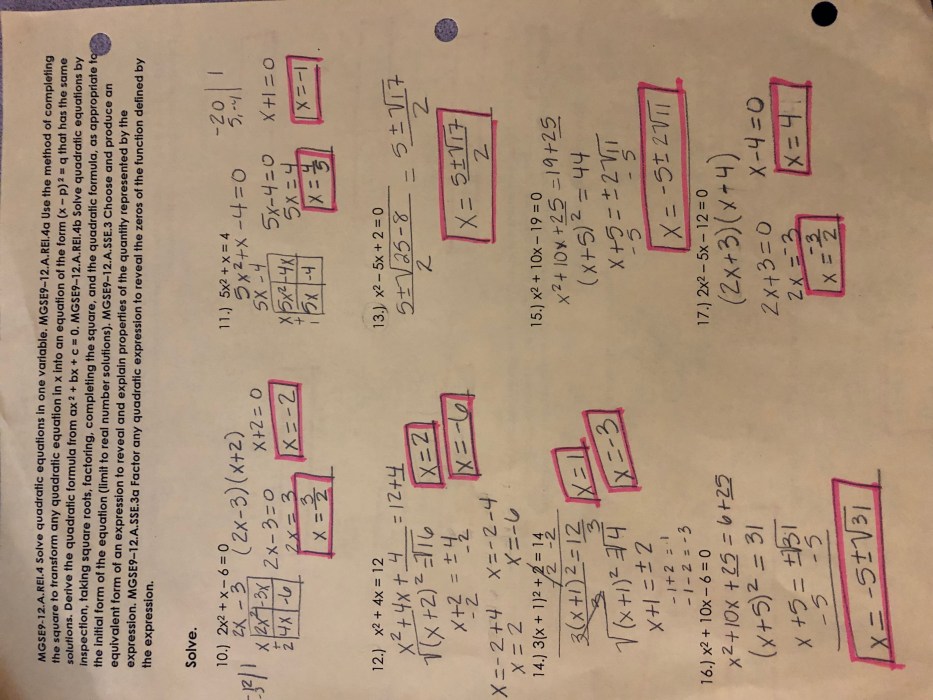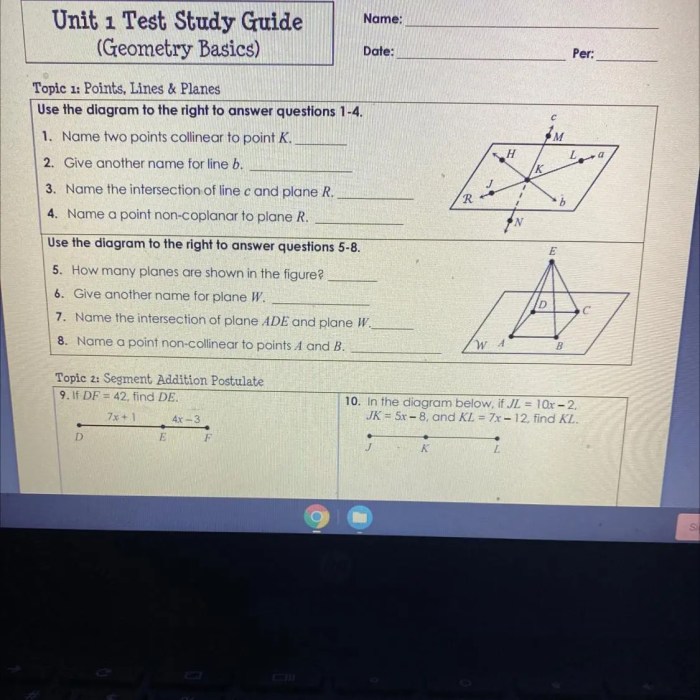Unit 1 test review geometry – Embark on a comprehensive journey through Unit 1 Geometry concepts, where we delve into the fundamentals of geometry, exploring points, lines, planes, and angles. We’ll unravel the mysteries of triangles and quadrilaterals, discovering their properties and classifications. Dive into the realm of area and perimeter, mastering formulas and solving problems with ease.
Transformations will take center stage, revealing their applications in architecture and design. Finally, coordinate geometry will illuminate the connection between points and shapes on a plane. Prepare to enhance your understanding of geometry and ace that upcoming test!
Unit 1 Geometry Concepts Review
Geometry is the branch of mathematics that deals with the properties of shapes. It is a fundamental subject that has applications in many fields, including architecture, engineering, and design.
Basic Concepts
The basic concepts of geometry include points, lines, planes, and angles. A point is a location in space that has no size. A line is a straight path that extends in both directions. A plane is a flat surface that extends in all directions.
An angle is formed by two lines that meet at a point.
Real-World Applications
Geometry has many applications in the real world. For example, architects use geometry to design buildings. Engineers use geometry to design bridges and other structures. Designers use geometry to create products that are both functional and aesthetically pleasing.
Types of Angles, Unit 1 test review geometry
There are many different types of angles. The most common types of angles are acute angles, right angles, obtuse angles, and straight angles.
| Type of Angle | Measurement |
|---|---|
| Acute angle | Less than 90 degrees |
| Right angle | 90 degrees |
| Obtuse angle | Greater than 90 degrees but less than 180 degrees |
| Straight angle | 180 degrees |
Triangles and Quadrilaterals

Triangles and quadrilaterals are two of the most basic geometric shapes. They have many different properties, and they can be classified in a variety of ways. In this section, we will explore the properties of triangles and quadrilaterals, and we will learn how to classify them.
Properties of Triangles
Triangles are polygons with three sides. The sum of the interior angles of a triangle is always 180 degrees. The exterior angle of a triangle is the angle formed by one side of the triangle and the extension of the adjacent side.
The sum of the exterior angles of a triangle is always 360 degrees.
Properties of Quadrilaterals
Quadrilaterals are polygons with four sides. The sum of the interior angles of a quadrilateral is always 360 degrees. The diagonals of a quadrilateral are the line segments that connect opposite vertices. The diagonals of a quadrilateral bisect each other.
For those who aced the unit 1 test review geometry, congratulations! Now, let’s shift gears to a different subject: chemistry. Don’t worry, we’ll circle back to geometry later. In the meantime, check out this resource on the UGA CHEM 1211 lab practical to get a head start on your studies.
Once you’re caught up, we’ll dive back into the intricacies of geometry and conquer those angles and shapes together.
Classifying Triangles and Quadrilaterals
Triangles and quadrilaterals can be classified in a variety of ways. Triangles can be classified by the length of their sides (scalene, isosceles, equilateral) or by the measure of their angles (acute, right, obtuse). Quadrilaterals can be classified by the length of their sides (trapezoid, parallelogram, rectangle, square) or by the measure of their angles (concave, convex).
Venn Diagram
A Venn diagram can be used to illustrate the relationships between different types of triangles and quadrilaterals. The Venn diagram below shows the relationships between the different types of triangles and quadrilaterals.

Area and Perimeter
Understanding the concepts of area and perimeter is essential in geometry. These measurements provide valuable insights into the size and shape of geometric figures, enabling us to solve various problems related to their dimensions.
In this section, we will explore the formulas for calculating the area and perimeter of different geometric shapes, including triangles, quadrilaterals, and more. We will also demonstrate how to apply these formulas to solve practical problems involving area and perimeter.
Calculating Area
Area refers to the amount of two-dimensional space occupied by a geometric figure. Different shapes have different formulas for calculating their area, depending on their specific characteristics.
- Triangle:Area = (1/2) × base × height
- Rectangle:Area = length × width
- Parallelogram:Area = base × height
- Trapezoid:Area = (1/2) × (base1 + base2) × height
- Circle:Area = π × radius 2
Calculating Perimeter
Perimeter, on the other hand, refers to the total length of the boundary of a geometric figure. It is calculated by adding up the lengths of all the sides of the figure.
- Triangle:Perimeter = side1 + side2 + side3
- Rectangle:Perimeter = 2 × (length + width)
- Parallelogram:Perimeter = 2 × (base + height)
- Trapezoid:Perimeter = side1 + side2 + side3 + side4
- Circle:Perimeter = 2π × radius
Table of Area and Perimeter Formulas
For quick reference, here is a table summarizing the area and perimeter formulas for different geometric shapes:
| Shape | Area | Perimeter |
|---|---|---|
| Triangle | (1/2) × base × height | side1 + side2 + side3 |
| Rectangle | length × width | 2 × (length + width) |
| Parallelogram | base × height | 2 × (base + height) |
| Trapezoid | (1/2) × (base1 + base2) × height | side1 + side2 + side3 + side4 |
| Circle | π × radius2 | 2π × radius |
Transformations

Geometric transformations are mathematical operations that move, flip, or turn geometric figures. They play a crucial role in various fields, from architecture to design.
The main types of transformations include translations, rotations, and reflections.
Translations
- A translation involves moving a figure from one point to another without changing its size or shape.
- It is represented by a vector that specifies the direction and distance of the movement.
Rotations
- A rotation involves turning a figure around a fixed point, called the center of rotation.
- It is represented by the angle of rotation and the direction of the turn.
Reflections
- A reflection involves flipping a figure over a line, called the line of reflection.
- It creates a mirror image of the original figure.
Applications
- In architecture, transformations are used to design buildings and structures that are symmetrical and visually appealing.
- In design, transformations are used to create patterns, logos, and other visual elements.
Flowchart for Performing a Transformation
- Identify the type of transformation.
- Determine the parameters of the transformation (e.g., vector for translation, angle for rotation).
- Apply the transformation to each point of the figure.
- Plot the transformed figure.
Coordinate Geometry
Coordinate geometry, also known as analytic geometry, is a branch of mathematics that deals with the representation of points and shapes using numbers. It is a powerful tool that allows us to describe and analyze geometric objects in a precise and systematic way.
The coordinate plane is a two-dimensional surface that is divided into four quadrants by two perpendicular lines called the x-axis and the y-axis. Each point on the coordinate plane is represented by an ordered pair of numbers (x, y), where x is the horizontal coordinate and y is the vertical coordinate.
To plot a point on the coordinate plane, we start at the origin (0, 0) and move x units to the right or left along the x-axis, and then move y units up or down along the y-axis. For example, the point (3, 4) is located 3 units to the right of the origin and 4 units up.
We can also use coordinate geometry to draw shapes. For example, to draw a rectangle with vertices at (0, 0), (3, 0), (3, 4), and (0, 4), we would first plot the four points on the coordinate plane. Then, we would connect the points with line segments to form the rectangle.
Coordinate geometry is a valuable tool for mathematicians, engineers, and scientists. It is used in a wide variety of applications, including computer graphics, robotics, and navigation.
Frequently Asked Questions: Unit 1 Test Review Geometry
What is the difference between a point and a line?
A point is a single, fixed location, while a line is a one-dimensional object that extends infinitely in both directions.
How do I calculate the area of a triangle?
To calculate the area of a triangle, use the formula: Area = (1/2) – base – height.
What is a transformation in geometry?
A transformation in geometry is an operation that moves, flips, or rotates a shape without changing its size or shape.